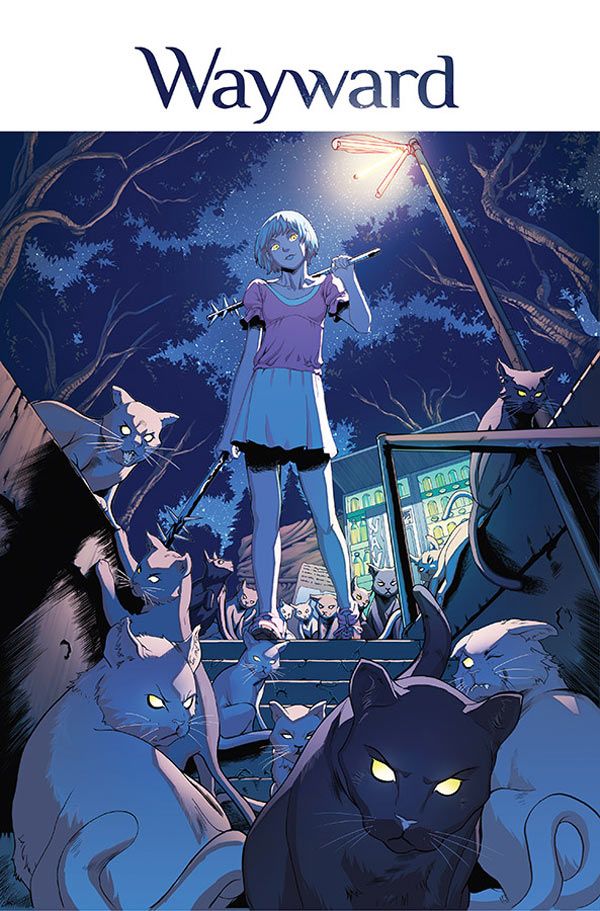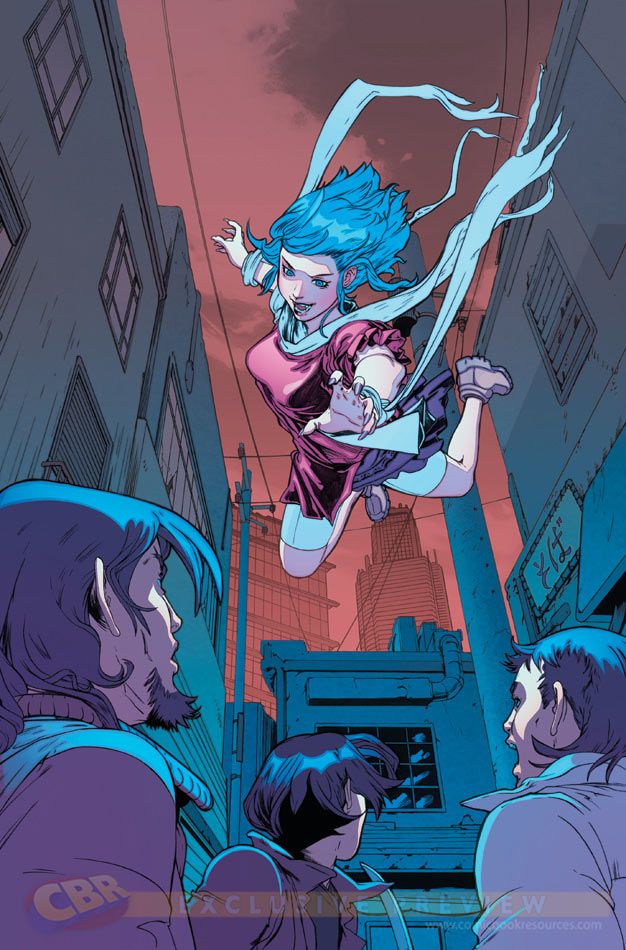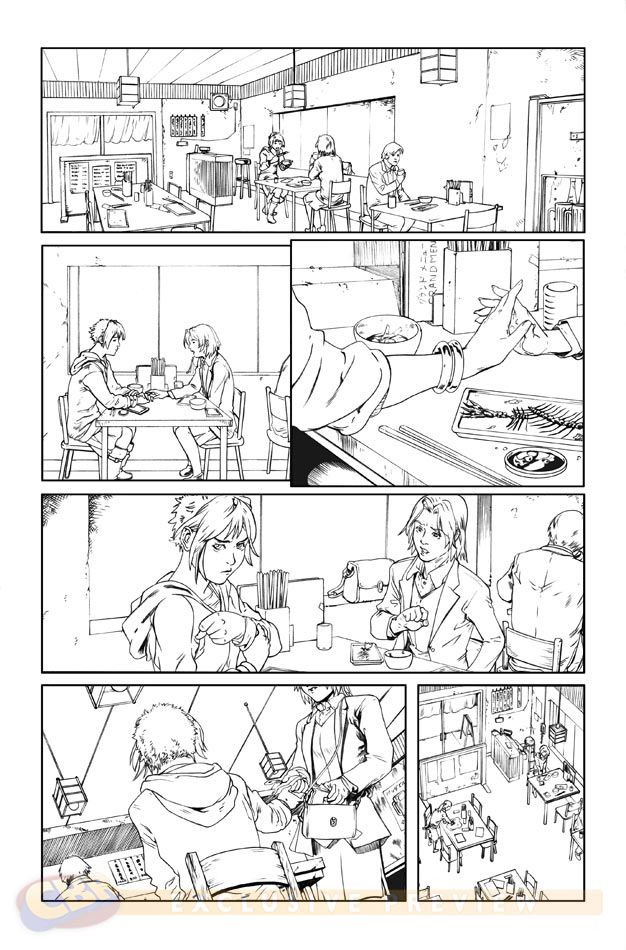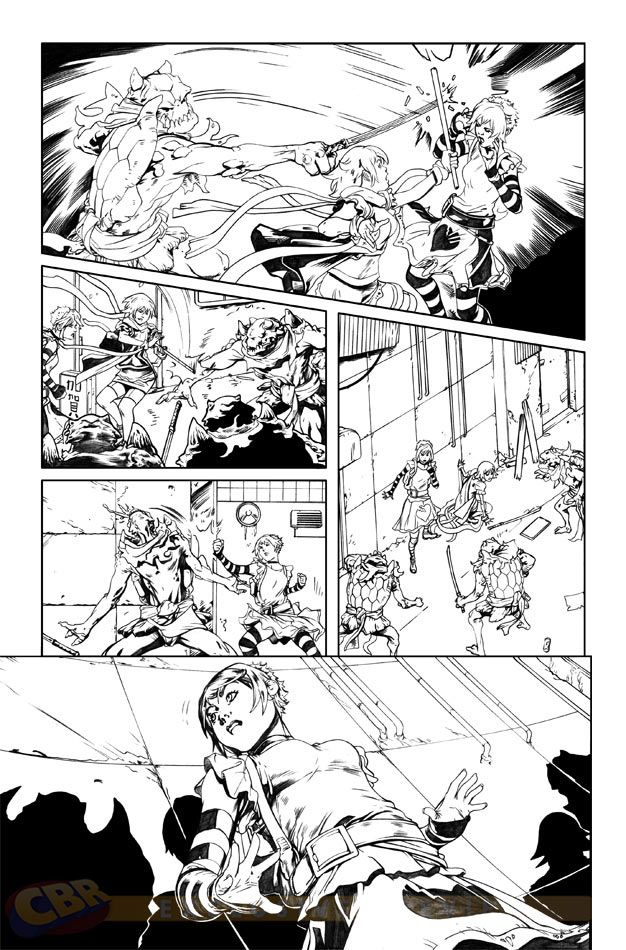Jim Zub is known for his work on a myriad of comics -- whether it's his creator-owned "Skullkickers" or his work on IDW's "Samurai Jack," Zub has a lot of books on his plate. In August, he adds a new creator-owned series to the stack with "Wayward," a new Image Comics book with co-creator and artist Steve Cummings. Taking place in Tokyo, Japan, "Wayward" follows the coming-of-age story of Rori Lane, a half-Irish/half-Japanese teenager who moves to Japan during her sophomore year of High School. And as glowing symbols and patterns start to appear in front of her, it's clear that something strange -- maybe even supernatural -- is going on.
To get more details on the series that Image called "'Buffy the Vampire Slayer' for a new generation," CBR News spoke with Jim Zub, who discussed the core concept of "Wayward," Rori's background, the origins of developing the book with Cummings, the importance of balancing both character building and the supernatural in the series' infancy and more.
Jim, tell us a bit about "Wayward." What's the core concept of the series and how did it come about?
Jim Zub: "Wayward" is a project I've been working with Steve on for a little while now. We wanted to do a story -- an action/supernatural story -- set in Tokyo. We're both big fans of Japan and Japanese mythology and we wanted to deliver that with a "Buffy"-style "teenagers fighting monsters" vibe, and put it all together in a really cool and appealing package.
If I were to sum the series up, Wayward is a bombastic supernatural story about myths and magic, and finding friends who will stand by you, against all odds.
The whole thing grew out of an illustration Steve did for "Vent", the UDON 10th Anniversary book that came out in 2010. I thought his piece was really eye-catching. I asked him, "What is this? Are you doing anything with this?" and he said, "Oh, I had this idea I wanted to do - something supernatural set in Japan, but I don't know much of how it would work beyond that."
I was like, "Really? I'd love to build that, use it as a springboard for ideas." We started plugging away, bouncing ideas back and forth. Slowly but surely, it evolved into "Wayward". Our first issue cover is Steve's original illustration, only in Vent it was in black & white.
"Wayward" was described as a coming-of-age story for Rori. Who is she and where does she find herself at the beginning of the book?
Rori is a half-Irish, half-Japanese girl who's never actually been to Japan. Her mother is Japanese but Rori grew up in Ireland. The family travelled around for her father's work, but they never went back to Japan. She has Japanese cultural elements her mother has instilled in her - language lessons, cultural lessons, and she's seen tons of photos - All of that has given her grounding in what Japan is all about, but no matter how much research she's done, she has no way of truly understanding it until she experiences the country firsthand.
Once her parents divorced, Rori stayed with her father for a while, but it didn't work out. In her second year of high school, she moves to Tokyo to be with her mother, and that's where the story begins, with her arriving in Tokyo for the first time. She has these expectations about what Japan is and what Japanese culture is and what living with her mother is going to be like but the reality of that, and beyond that, the hyper-reality of the supernatural, is going to take hold.
You mentioned earlier that you had an interest in Japanese mythology and Japan. How grounded in Japanese mythology will the series be?
The most important part for me is the character development. Obviously, the myths and the folklore and the monsters are all very cool, and all of that's going to be grounded in ideas that are part of Japanese folklore, but I don't want readers to feel like they need to be fans of that stuff to dig in to this story. The core part is the characters and the teenage story and the action-packed elements of it.
That said, I've definitely been researching Yokai, the ghosts and the phantoms and the Bakemono -- all the different monstrous elements, but we're not trying to be encyclopedic in our knowledge. We're taking bits and pieces of it and imbuing these stories with really cool and exotic monsters -- well, exotic to North American readers -- while giving them a modern spin. We're trying to imagine how those creatures could exist in the modern world - where they would be hidden; how they would influence the culture and the society in hidden ways.
Shifting to the subject of character, this is obviously a book that has to walk a delicate balance between the supernatural and regular teenage problems. What has the experience been like for you in walking that line and balance those two elements?
It's interesting, right? It's such a different story than people might expect from me. "Skullkickers" is a big, silly, slapstick book and it's never been very deep in terms of character. Really digging in on this cast and building an emotional core for them has been great. I want to make sure readers get a feel for who they are, what their struggles are and the difficulties they're going through; then exemplify that against the conflict they have against the supernatural.
So, as much as we have cool visuals -- and I'm pretty sure Steve's art will bring people in the door -- if readers don't care about these characters then they won't come back issue after issue and see how it all evolves.
What about the supporting cast? Who else features in the series alongside Rori?
We've got four 'main' teenagers in the first story arc. Each of them embodies different elements. Rori's half-Japanese and the other three -- two of them are definitely Japanese, and one of them has got her own thing going on. I can't say too much without spoiling what's coming in the story. Anyway you've got two character that have grown up in Japan and are Japanese students, and then you have Rori, who's discovering cultural stuff about Japan and also about herself and how she's going to fit in here, this city that isn't quite what she expected to be. She's trying to establish her new life while at the same time coming up against twisted monsters and all sorts of crazy stuff.
Talk a little bit about Steve's art and how his style has been a good fit for the story you two have developed together.
Well, the nice thing is that since we built this story from the ground up -- Steve and I are co-creators on this and we're building it together -- it's not something where I have a story and I tried to find an artist who would fit. It started from that original concept art and built upwards from there. Steve is the perfect fit because "Wayward" is the two of us together on it. He's a North American guy who grew up in the States and moved to Japan. He took art school there and has been living there and raising a family for years now just outside Tokyo. He brings the cultural knowledge and helps to fill in stuff that I didn't know about, while we both contribute our love of Japan and myths and the fantastical elements of it all together.
Steve's artwork has a Japanese flare, but I wouldn't say it's "Manga" through and through. It definitely has those notes - but beyond that and he's got a classic comic sensibility, a grounding in beautiful environmental drawing, elegant design, and strong storytelling. He's the perfect artist for Wayward because we built it for him.
You've got a lot of different books on the burner currently; how does "Wayward" scratch a different creative itch for you than your other work?
I'm known for a lot of sword and sorcery stuff, and I love magic and fantasy storytelling, but what's nice is that "Wayward" is going to bring people something they may not have seen in my work before. If people read the "Suicide Squad: Amanda Waller" special I did for DC, that had more character depth. The same goes for the ensemble cast I'm writing for Dynamite's "Pathfinder".
I want to bring some of those strong character interactions into my creator-owned work. Don't get me wrong, there will be fun stuff -- the "Buffy" analogy in the announcement is accurate because we're going to have emotional elements and pathos in there, but also action and banter. I want to bring some of those fun sensibilities that people know from my work, but not as much of the cartoonish stuff you see in "Skullkickers" or that you're seeing in "Samurai Jack" from time to time. It's a more nuanced series. Wayward has action notes and emotional notes, and hopefully it really shows people a broader sense of what I'm capable of.
Whatever happens, I know it's not going to fail because of the art, because Steve is killing it on every single page.
Monster-hunters have had many different incarnations in popular media. What makes "Wayward" unique among some of the other options out there?
At the heart of "Wayward" is not just a story about myth and magic, it's also about generational divide and the fact that we as a world are changing. It's an interesting time because we're becoming a more global culture. With each successive generation we're seeing that teenagers are becoming more connected and more globally aware, that they can have a much more global influence. These kids don't just represent specific teens, they represent a generation of thought -- a new generational consciousness. The mythological elements keep the story moving, but these teens are more than just Hollywood cliches. We're moving into a much more aware generation, where people can be awkward and cool at the same time. Coming of age isn't just a matter of picking a stereotype - the jock, the geek, the cheerleader, whatever - it's about broadening your vision of the world you're coming into and the person you're meant to be.
Anything else you'd like to add about "Wayward?"
As always, people can keep track of what I'm up to on JimZub.com, and I'm pretty active on Twitter as well. I love talking process and I love interacting with people who are reading my work.
Image is on such a tear right now, and I'm incredibly proud to have a new creator-owned book coming out this summer. The changes that have occurred in this industry since I launched "Skullkickers" in 2010 are a bit mind boggling. There's a massive surge in creator-owned comics and new ideas on the march. The way creator-owned is being embraced by retailers, readers, and pop culture in general makes it such an awesome time to create something new. Being at Image and launching Wayward-a title I'm so passionate about and Steve is so passionate about -- it's the best. I can't wait for people to jump on board.
"Wayward" #1 hits stores August 27





